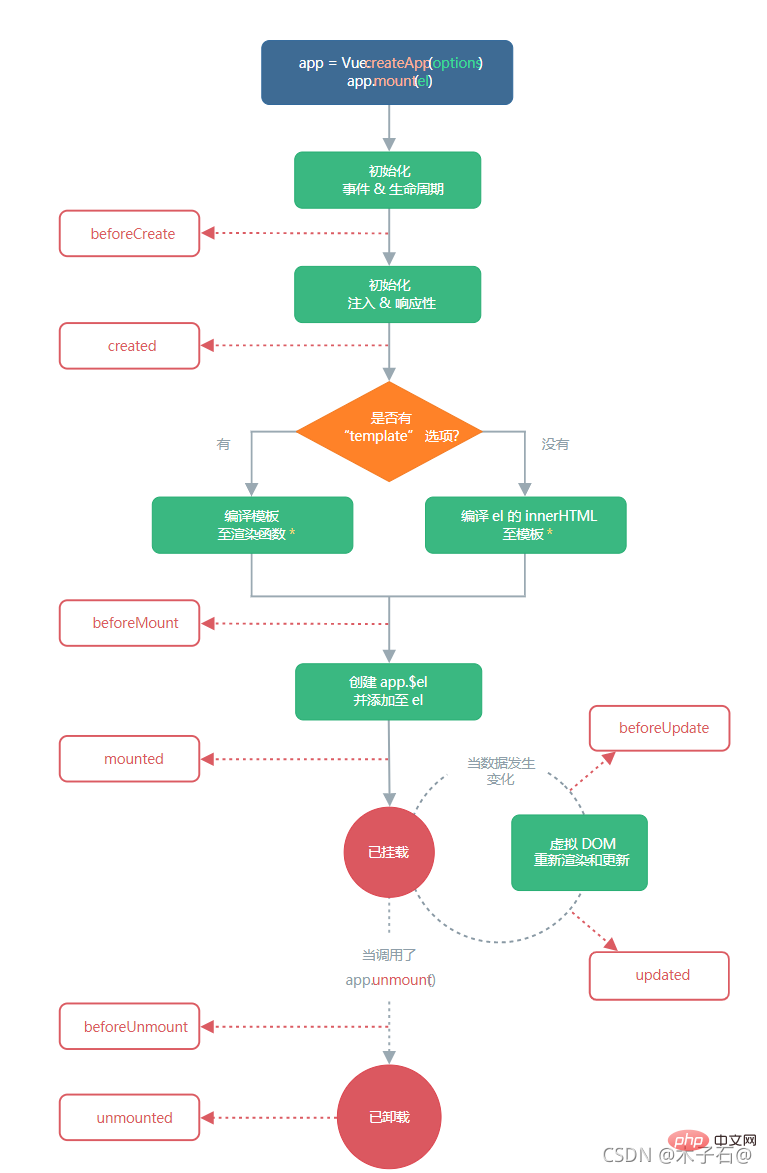本篇文章给大家带来了vue3与vue2的部分区别的相关知识,其中包括生命周期变化、实例变化以及方法变化等等,希望对大家有帮助。



不难看出,vue3.0与vue2.0之间生命周期函数在销毁的时候有变化:
beforeDestroy --> beforeUnmount destroyed --> unmounted
其他的区别主要在于书写使用的语言上的差别 在ts中使用 class 类组件书写可以 参考 vue-class-component 或者 vue-property-decorator 书写的风格和vue2.0的选项式区别不大。 如果使用js书写代码 则应当使用组合式。
具体变化带来的问题,会在下面的组合式写法中讲解。
// 之前(Vue 2.x)
Vue.prototype.$http = () => {}
Vue.prototype.url= 'http://123'
// 之后(Vue 3.x)
const app = createApp({})
app.config.globalProperties.$http = () => {}
app.config.globalProperties.url= 'http://123'//=======vue3.x
//使用createApp函数来实例化vue,
//该函数接收一个根组件选项对象作为第一个参数
//使用第二个参数,我们可以将根 prop 传递给应用程序
import { createApp } from 'vue'
import App from './App.vue'
import router from './router'
import store from './store'
createApp(App,{ userName: "blackLieo" })
.use(store)
.use(router)
.mount('#app')
//由于 createApp 方法返回应用实例本身,因此可以在其后链式调用其它方法,这些方法可以在以下部分中找到。
//=======vue2.x
import Vue from 'vue'
import App from './App.vue'
import router from './router'
import store from './store'
Vue({
router,
store,
render: h => h(App)
}).$mount('#app')//================vue2.0使用插槽基本上直接使用slot进行操作//其中vue2.0经历了两次更迭,2.6.0版本slot升级为v-slot<p>
<slot :current="toolTipData" name="test"></slot> // 具名 作用域插槽
<slot></slot> //默认插槽</p>//父组件调用该组件<test>
<template>
<p>默认插槽</p>
</template>
// 作用域插槽
<template slot-scope="{ current }" slot="test">
<el-form label-width="80px" :model="current">
<el-form-item label="id:">
<el-link type="info">{{ current.id }}</el-link>
</el-form-item>
<el-form-item label="name:">
<el-link type="info">{{ current.name }}</el-link>
</el-form-item>
<el-form-item label="label:">
<el-link type="info">{{ current.label }}</el-link>
</el-form-item>
<el-form-item label="group:">
<el-link type="info">{{ current.group }}</el-link>
</el-form-item>
<el-form-item label="runtime:">
<el-link type="info">{{ current.runtime }}</el-link>
</el-form-item>
<el-form-item label="category:">
<el-link type="info">{{ current.category }}</el-link>
</el-form-item>
</el-form>
</template>
</test>
//==============vue3.0使用插槽//在vue3.0中,插槽使用v-slot 简写用#<p>
<slot name="test" :newData="slotsData"></slot>
<slot></slot></p><HelloWorld msg="Welcome to Your Vue.js + TypeScript App">
<template #default> // 可以写为v-slot:default #后面跟的是插槽名称
<p>默认插槽</p>
</template>
//作用域插槽
<template #test="{ newData }"> // 可以写为v-slot:test="newData"
<p>{{ newData.aa }}</p>
<p>{{ newData.bb }}</p>
</template></HelloWorld>//一个组件里面具有多个插槽时,一定要带上名称,否则可能会导致作用域错乱在 Vue 2 中实现一个自定义指令:
// 注册一个全局自定义指令 `v-focus`Vue.directive('focus', {
// 当被绑定的元素插入到 DOM 中时……
inserted: function (el) {
// 聚焦元素
el.focus()
}})在 Vue 2 中, 自定义指令通过以下几个可选钩子创建:
- bind:只调用一次,指令第一次绑定到元素时调用。在这里可以进行一次性的初始化设置。
- inserted:被绑定元素插入父节点时调用(仅保证父节点存在,但不一定已被插入文档中)。
- update:所在组件的 VNode 更新时调用,但是可能发生在其子 VNode更新之前。指令的值可能发生了改变,也可能没有。但是你可以通过比较更新前后的值来忽略不必要的模板更新 (详细的钩子函数参数见下)。
- componentUpdated:指令所在组件的 VNode 及其子 VNode 全部更新后调用。
- unbind:只调用一次,指令与元素解绑时调用。
在 Vue 3 中对自定义指令的 API 进行了更加语义化的修改, 就如组件生命周期变更一样, 都是为了更好的语义化, 变更如下:
所以在 Vue3 中, 可以这样来自定义指令:
const { createApp } from "vue"const app = createApp({})app.directive('focus', {
mounted(el) {
el.focus()
}})然后可以在模板中任何元素上使用新的 v-focus指令, 如下:
<input v-focus />
Vue 3 中 v-model 发生了很大的变化:
变更:在自定义组件上使用v-model时, 属性以及事件的默认名称变了 变更:v-bind的.sync修饰符在 Vue 3 中又被去掉了, 合并到了v-model里 新增:同一组件可以同时设置多个 v-model 新增:开发者可以自定义 v-model修饰符
我们来详细了解一下,并对比一下vue2与vue3 在组件上使用 v-model,
例如:
vue2 的输入框的双向绑定,其实就相当于传递了value属性, 并触发了input事件:
<!-- Vue 2 --> <input v-model="searchValue"><input> <!-- 相当于 --> <input :value="searchValue" @input="searchValue=$event"><input>
这时v-model只能绑定在组件的value属性上,那如果我们要给自己的组件用一个别的属性,并且我们不想通过触发input来更新值。
但是在实际开发中,有些场景我们可能需要对一个 prop 进行 “双向绑定”, 这里以最常见的 dialog 为例子:dialog 挺合适属性双向绑定的, 外部可以控制组件的visible显示或者隐藏,组件内部关闭可以控制 visible属性隐藏,同时 visible 属性同步传输到外部。组件内部, 当我们关闭dialog时, 在子组件中以 update:PropName 模式触发事件。
事件为
this.$emit('update:visible', false)然后在父组件中可以监听这个事件进行数据更新:
<el-dialog :visible="isVisible" @update:visible="isVisible = $event"></el-dialog>
在vue2的开发中,我们实际会发现一个新的东西sync,所以也可以使用v-bind.sync来简化实现:
<el-dialog :visible.sync="isVisible"></el-dialog>
上面说了 Vue2 中v-model实现以及组件属性的双向绑定,那么在 Vue 3 中应该怎样实现的呢?
在 Vue3 中, 在自定义组件上使用v-model, 相当于传递一个modelValue 属性, 同时触发一个update:modelValue事件:
<el-dialog v-model="isVisible"></el-dialog> <!-- 相当于 --> <el-dialog :modelValue="isVisible" @update:modelValue="isVisible = $event"></el-dialog>
如果要绑定属性名, 只需要给v-model传递一个参数就行, 同时可以绑定多个v-model:
<el-dialog v-model:visible="isVisible" v-model:content="content"></el-dialog><!-- 相当于 --><el-dialog :visible="isVisible"
:content="content"
@update:visible="isVisible"
@update:content="content"></el-dialog>这个写法完全没有.sync什么事儿了, Vue 3 中抛弃了.sync写法, 统一使用v-model。
Vue3 中 使用 defineAsyncComponent 定义异步组件,配置选项 component 替换为 loader ,Loader 函数本身不再接收 resolve 和 reject 参数,且必须返回一个 Promise,用法如下:
<template>
<!-- 异步组件的使用 -->
<AsyncPage /></tempate><script>import { defineAsyncComponent } from "vue";export default {
components: {
// 无配置项异步组件
AsyncPage: defineAsyncComponent(() => import("./NextPage.vue")),
// 有配置项异步组件
AsyncPageWithOptions: defineAsyncComponent({
loader: () => import("./NextPage.vue"),
delay: 200,
timeout: 3000,
errorComponent: () => import("./ErrorComponent.vue"),
loadingComponent: () => import("./LoadingComponent.vue"),
})
},}</script>使用Composition API 解决我们在完成功能时,在 data、methods、computed 以及 mounted 中反复的跳转,他将零散分布的 逻辑组合在一起维护,并可以将单独的逻辑再分为单独的文件
如果想要了解<script setup></script>语法糖,请移步 vue3 setup语法糖(部分总结)
我们先来了解一下Composition具有的API
setup 是 Vue3.x 新增的一个选项, 他是组件内使用 Composition API的入口。
setup 执行时机
通过一段代码 我们可以知道:
<script>import { defineComponent, reactive } from "vue";export default defineComponent({
beforeCreate() {
console.log("----beforeCreate----");
},
created() {
console.log("----created----");
},
setup() {
const state = reactive({ count: 0 });
console.log("----setup----");
return {
state,
};
},});</script>会出现如下所示的输出结果:
setup 执行时机是在 beforeCreate 之前执行,详细的可以看后面生命周期讲解。
使用setup时,它接受两个参数:
- props: 组件传入的属性
- context
setup 中接受的props是响应式的, 当传入新的 props 时,会及时被更新。
由于是响应式的, 所以不可以使用 ES6 解构,解构会消除它的响应式。
错误代码示例, 这段代码会让 props 不再支持响应式:
setup(props) {
const { name } = props;
console.log(name);
const state = reactive({ count: 0 });
return {
state,
};
},对于以上的的问题,我们可以在后面的toRefs进行解释。
现在我们就来讲一下:
在 vue2.x 中, 定义数据都是在data中。
但是 Vue3.x 可以使用reactive和ref来进行数据定义。
那么ref和reactive他们有什么区别呢?
reactive用于处理对象的双向绑定,ref处理 js 基础类型或者处理对象的双向绑定。 注意refs 它接受一个内部值并返回一个响应式且可变的 ref 对象。ref 对象具有指向内部值的单个 property.value。
<template>
<p>
<p>计数:{{ num }}s</p>
<p>主人年龄:{{ person.age }}</p>
<p>主人姓名:{{ person.name }}</p>
<p>动物类别:{{ animal.type }}</p>
<p>动物名称:{{ animal.name }}</p>
<p>动物年龄:{{ animal.age }}</p>
</p></template><script>import { defineComponent, reactive, ref } from "vue";export default defineComponent({
setup() {
//使用ref声明基本类型
const num = ref(0);
//使用ref声明对象
const person = ref({ age: 20, name: "张三" });
//使用reactive声明对象
const animal = reactive({ type: "猫", name: "小花", age: 5 });
setTimeout(() => {
person.value.age = person.value.age + 1;
person.value.name = "李四";
animal.age++;
}, 1000);
setInterval(() => {
num.value++;
}, 1000);
return {
num,
animal,
person,
};
},});</script>我们绑定到页面是通过user.name,user.age;这样写感觉很繁琐,我们能不能直接将user中的属性解构出来使用呢?
答案是不能直接对user进行结构, 这样会消除它的响应式, 这里就和上面我们说props不能使用 ES6 直接解构就呼应上了。
那我们就想使用解构后的数据怎么办,解决办法就是使用toRefs。toRefs 用于将一个 reactive 对象转化为属性全部为 ref 对象的普通对象。具体使用方式如下:
<template>
<p>
<p>计数:{{ num }}s</p>
<p>主人年龄:{{ person.age }}</p>
<p>主人姓名:{{ person.name }}</p>
<p>动物类别:{{ atype }}</p>
<p>动物名称:{{ aname }}</p>
<p>动物年龄:{{ aage }}</p>
</p></template><script>import { defineComponent, reactive, ref, toRefs } from "vue";export default defineComponent({
setup() {
//使用ref声明基本类型
const num = ref(0);
//使用ref声明对象
const person = ref({ age: 20, name: "张三" });
//使用reactive声明对象
const animal = reactive({ atype: "猫", aname: "小花", aage: 5 });
setTimeout(() => {
person.value.age = person.value.age + 1;
person.value.name = "李四";
animal.aage++;
}, 1000);
setInterval(() => {
num.value++;
}, 1000);
return {
num,
person,
...toRefs(animal),
};
},});</script>有时我们想跟踪响应式对象 (ref 或 reactive) 的变化,但我们也希望防止在应用程序的某个位置更改它,这时候,我们就需要readonly。
例如,当我们有一个被传递的响应式对象时,我们不想让它在传递的的时候被改变。为此,我们可以基于原始对象创建一个只读的 proxy 对象:
import { reactive, readonly } from 'vue'
const original = reactive({ count: 0 })
const copy = readonly(original)
// 通过 original 修改 count,将会触发依赖 copy 的侦听器
original.count++
// 通过 copy 修改 count,将导致失败并出现警告
copy.count++ // 警告: "Set operation on key 'count' failed: target is readonly."在最开始的时候,我们就看到了两张图,其中的变化我们可以总结一下

我们可以看到beforeCreate和created被setup替换了(但是 Vue3 中你仍然可以使用, 因为 Vue3 是向下兼容的, 也就是你实际使用的是 vue2 的)。
其次,钩子命名都增加了on; Vue3.x 还新增用于调试的钩子函数onRenderTriggered和onRenderTricked
下面我们简单使用几个钩子, 方便大家学习如何使用,Vue3.x 中的钩子是需要从 vue 中导入的:
import {
defineComponent,
onBeforeMount,
onMounted,
onBeforeUpdate,
onUpdated,
onBeforeUnmount,
onUnmounted,
onErrorCaptured,
onRenderTracked,
onRenderTriggered,} from "vue";export default defineComponent({
//beforeCreate和created是vue2的
beforeCreate() {
console.log("------beforeCreate-----");
},
created() {
console.log("------created-----");
},
setup() {
console.log("------setup-----");
// vue3.x生命周期写在setup中
onBeforeMount(() => {
console.log("------onBeforeMount-----");
});
onMounted(() => {
console.log("------onMounted-----");
});
onBeforeUpdate(() => {
console.log("------onBeforeUpdate-----");
});
onUpdated(() => {
console.log("------onUpdated-----");
});
onBeforeUnmount(() => {
console.log("------onBeforeUnmount-----");
});
onUnmounted(() => {
console.log("------onUnmounted-----");
});
onErrorCaptured(() => {
console.log("------onErrorCaptured-----");
});
onRenderTracked(() => {
console.log("------onRenderTracked-----");
});
// 调试哪些数据发生了变化
onRenderTriggered((event) => {
console.log("------onRenderTriggered-----", event);
});
},});具体怎么使用,是干什么的请参考官方文档,这里就不一一赘述了。
watch 函数用来侦听特定的数据源,并在回调函数中执行副作用。默认情况是惰性的,也就是说仅在侦听的源数据变更时才执行回调。
watch(source, callback, [options])
参数说明:
- source: 可以支持 string,Object,Function,Array;
- 用于指定要侦听的响应式变量 callback:
- 执行的回调函数 options:支持 deep、immediate 和 flush 选项。
其实整体和原来的vue2.0有一定的相似性,基本参数没有发生大的改变。
接下来我会分别介绍这个三个参数都是如何使用的, 如果你对 watch 的使用不明白的请往下看:
//监听reactive对象:watch(
() => animal.aage,
(curAge, preAge) => {
console.log("新值:", curAge, "老值:", preAge);
}
);//监听ref变量
watch(num, (newVal, oldVal) => {
console.log("新值:", newVal, "老值:", oldVal);
});
//多个值的监听
watch([() => animal.aage, num], ([curAge, newVal], [preAge, oldVal]) => {
console.log("新值:", curAge, "老值:", preAge);
console.log("新值:", newVal, "老值:", oldVal);
});
//监听对象复杂时,请使用深度监听 让函数的第三个参数为deep:truewatch(
() => state.animal,
(newType, oldType) => {
console.log("新值:", newType, "老值:", oldType);
},
{ deep: true }
);默认情况下,watch 是惰性的, 那什么情况下不是惰性的, 可以立即执行回调函数呢?其实使用也很简单, 给第三个参数中设置immediate: true即可。
//停止监听函数
const stopWatchRoom = watch(
() => state.animal,
(newType, oldType) => {
console.log("新值:", newType, "老值:", oldType);
},
{ deep: true }
);
setTimeout(() => {
// 停止监听
stopWatchRoom();
}, 3000);还有一个监听函数watchEffect,介绍一下watchEffect,看看它的使用和watch究竟有何不同,在上面代码的基础上,我们来编写。
watchEffect(() => {
console.log(num);
});执行结果首先打印一次num值;然后每隔一秒,打印num值。
从上面的代码可以看出, 并没有像watch一样需要先传入依赖,watchEffect会自动收集依赖, 只要指定一个回调函数。在组件初始化时, 会先执行一次来收集依赖, 然后当收集到的依赖中数据发生变化时, 就会再次执行回调函数。所以总结对比如下:
- watchEffect 不需要手动传入依赖
- watchEffect 会先执行一次用来自动收集依赖
- watchEffect无法获取到变化前的值, 只能获取变化后的值
在之前vue用的mixin,所谓的混入 (mixin) 提供了一种非常灵活的方式,来分发 Vue 组件中的可复用功能。一个混入对象可以包含任意组件选项。当组件使用混入对象时,所有混入对象的选项将被“混合”进入该组件本身的选项。
现在的vue3.0提供了一种新的东西 vue-hooks。具体的vue-hooks,请参考网上教程
为什么产生了hooks?
首先从class-component/vue-options说起:
- 跨组件代码难以复用
- 大组件,维护困难,颗粒度不好控制,细粒度划分时,组件嵌套存层次太深影响性能
- 类组件,this不可控,逻辑分散,不容易理解
- mixins具有副作用,逻辑互相嵌套,数据来源不明,且不能互相消费
当一个模版依赖了很多mixin的时候,很容易出现数据来源不清或者命名冲突的问题,而且开发mixins的时候,逻辑及逻辑依赖的属性互相分散且mixin之间不可互相消费。这些都是开发中令人非常痛苦的点。
hooks存在以下优势:
- 允许hooks间相互传递值
- 组件之间重用状态逻辑
- 明确指出逻辑来自哪里
我们先来封装一个hooks,假如这个hooks是一个实现年龄加减,获取双倍年龄的函数。用单独的文件存储 bus/useAge.ts
import { ref, Ref, computed } from "vue";type CountResultProps = {
age: Ref<number>;
doubleAge: Ref<number>;
increase: (curAge?: number) => void;
decrease: (curAge?: number) => void;};export default function useCount(initValue = 20): CountResultProps {
const age = ref(initValue);
const increase = (curAge?: number): void => {
if (typeof curAge !== "undefined") {
age.value += curAge;
} else {
age.value += 1;
}
};
const doubleAge = computed(() => age.value * 2);
const decrease = (curAge?: number): void => {
if (typeof curAge !== "undefined") {
age.value -= curAge;
} else {
age.value -= 1;
}
};
return {
age,
doubleAge,
increase,
decrease,
};}在组件里面调用该hooks
<template>
<p>
<p>计数:{{ num }}s</p>
<p>主人年龄:{{ person.age }}</p>
<p>主人姓名:{{ person.name }}</p>
<p>动物类别:{{ atype }}</p>
<p>动物名称:{{ aname }}</p>
<p>动物年龄:{{ aage }}</p>
<p>count: {{ age }}</p>
<p>双倍年龄: {{ doubleAge }}</p>
<p>
<button @click="increase()">加1</button>
<button @click="decrease()">减一</button>
</p>
</p></template><script>import {
defineComponent,
reactive,
ref,
toRefs,
watch,
watchEffect,} from "vue";import useAge from "../bus/useAge.ts";export default defineComponent({
setup() {
//使用ref声明基本类型
const num = ref(0);
//使用ref声明对象
const person = ref({ age: 20, name: "张三" });
//使用reactive声明对象
const animal = reactive({ atype: "猫", aname: "小花", aage: 5 });
setTimeout(() => {
person.value.age = person.value.age + 1;
person.value.name = "李四";
animal.aage++;
animal.aname = "小橘";
}, 1000);
setInterval(() => {
num.value++;
}, 1000);
const { age, doubleAge, increase, decrease } = useAge(22);
return {
num,
person,
...toRefs(animal),
age,
doubleAge,
increase,
decrease,
};
},});</script>在vue2.0中,应该很多人都使用了$set这个东西吧。
数据更新了,页面为什么不变化呢?什么时候我们用$forceUpdate强制更新呢?
在vue2.x中,实现数据监听使用的是Object.defineProperty。而vue3.x使用的是Proxy
Object.defineProperty只能劫持对象的属性, 而 Proxy 是直接代理对象由于
Object.defineProperty只能劫持对象属性,需要遍历对象的每一个属性,如果属性值也是对象,就需要递归进行深度遍历。
但是Proxy直接代理对象, 不需要遍历操作
Object.defineProperty对新增属性需要手动进行Observe
因为
Object.defineProperty劫持的是对象的属性,所以新增属性时,需要重新遍历对象,
对其新增属性再次使用Object.defineProperty进行劫持。也就是 Vue2.x
中给数组和对象新增属性时,需要使用$set才能保证新增的属性也是响应式的,
$set内部也是通过调用Object.defineProperty去处理的。
Proxy有多种拦截方法,如apply,deleteProperty等等,是Object.defineProperty()不具备的。Proxy是返回值是一个对象,可以直接进行操作,而defineProperty()要先遍历所有对象属性值才能进行操作。Object.defineProperty()兼容性高一些。Teleport 是 Vue3.x 新推出的功能
Teleport 是什么呢?
Teleport 就像是哆啦 A 梦中的「任意门」,任意门的作用就是可以将人瞬间传送到另一个地方。有了这个认识,我们再来看一下为什么需要用到 Teleport 的特性呢,看一个小例子:
例如我们在使用
Dialog组件时,我们实际开发中经常会使用到Dialog,此时Dialog就被渲染到一层层子组件内部,处理嵌套组件的定位、z-index和样式都变得困难。但是组件希望位于页面的最上方,这时候我们将Dialog组件挂载在body上面是最好控制的,我们能够很好的通过zIndex来控制Dialog的位置,当他嵌套在templat里面的时候就不那么容易了。简单来说就是,即希望继续在组件内部使用Dialog,又希望渲染的DOM结构不嵌套在组件内部的DOM中。
此时就需要 Teleport 上场,我们可以用<Teleport>包裹Dialog, 此时就建立了一个传送门,可以将Dialog渲染的内容传送到任何指定的地方。
<template>
<p>
<p>计数:{{ num }}s</p>
<p>主人年龄:{{ person.age }}</p>
<p>主人姓名:{{ person.name }}</p>
<p>动物类别:{{ atype }}</p>
<p>动物名称:{{ aname }}</p>
<p>动物年龄:{{ aage }}</p>
<p>count: {{ age }}</p>
<p>倍数: {{ doubleAge }}</p>
<p>
<button @click="increase()">加1</button>
<button @click="decrease()">减一</button>
</p>
<el-button type="text" @click="dialogVisible = true"
>点击打开 Dialog</el-button >
<teleport to="#dialogLL">
<el-dialog title="提示" v-model="dialogVisible" width="30%">
<span>这是一段信息</span>
<template #footer>
<span class="dialog-footer">
<el-button @click="dialogVisible = false">取 消</el-button>
<el-button type="primary" @click="dialogVisible = false"
>确 定</el-button >
</span>
</template>
</el-dialog>
</teleport>
</p></template><script>import {
defineComponent,
reactive,
ref,
toRefs,} from "vue";export default defineComponent({
setup() {
//使用ref声明基本类型
const num = ref(0);
const dialogVisible = ref(false);
//使用ref声明对象
const person = ref({ age: 20, name: "张三" });
//使用reactive声明对象
const animal = reactive({ atype: "猫", aname: "小花", aage: 5 });
setTimeout(() => {
person.value.age = person.value.age + 1;
person.value.name = "李四";
animal.aage++;
animal.aname = "小橘";
}, 1000);
setInterval(() => {
num.value++;
}, 1000);
return {
dialogVisible,
num,
person,
...toRefs(animal),
};
},});</script>我们可以很清楚的看到teleport上有一个to属性,这个属性是讲当前节点传送到制定位置去的。位置应该传送到哪里呢?
答案就是在index.html上面
下面是我们的首页 你会看到有一个p的ID名为dialogLL,teleport就将节点挂载在这里来了
<!DOCTYPE html><html lang="en"> <head> <meta charset="UTF-8" /> <link rel="icon" href="/favicon.ico" /> <meta name="viewport" content="width=device-width, initial-scale=1.0" /> <title>Vite App</title> </head> <body> <p id="app"></p> <p id="dialogLL"></p> <script type="module" src="/src/main.js"></script> </body></html>
如图所示:
Suspense是 Vue3.x 中新增的特性, 那它有什么用呢?我们通过 Vue2.x 中的一些场景来认识它的作用。 Vue2.x 中应该经常遇到这样的场景:
<template> <p> <p v-if="!loading">...</p> <p v-if="loading">加载中...</p> </p></template>
在前后端交互获取数据时, 是一个异步过程,一般我们都会提供一个加载中的动画,当数据返回时配合v-if来控制数据显示。
它提供两个template slot, 刚开始会渲染一个 fallback 状态下的内容, 直到到达某个条件后才会渲染 default 状态的正式内容, 通过使用Suspense组件进行展示异步渲染就更加的简单。
具体的使用,我们可以用下面的例子来表示:
这是需要等待取值完成的的组件:
<template>
<h1>{{ getData.result }}</h1></template><script>export default {
name: "NewModel",
async setup() {
let getData = await new Promise((resolve) => {
setTimeout(() => {
return resolve({ result: "OK" });
}, 3000);
});
return {
getData,
};
},};</script>在其他组件内调用它,当等待取值的组件取值完成后,会将loading状态变为OK状态
<template>
<p>
<suspense>
<template #default>
<NewSuspense></NewSuspense>
</template>
<template #fallback>
<h1>Loadding...</h1>
</template>
</suspense>
</p></template><script>import NewSuspense from "./suspens.vue";export default {
name: "AppMain",
components: {
NewSuspense,
},};</script><style></style>效果如图:
在 Vue2.x 中, template中只允许有一个根节点:
<template> <p> <span></span> <span></span> </p></template>
但是在 Vue3.x 中,你可以直接写多个根节点:
<template> <span></span> <span></span></template>
Vue3.x 在考虑到 tree-shaking的基础上重构了全局和内部 API, 表现结果就是现在的全局 API 需要通过 ES Module的引用方式进行具名引用, 比如在 Vue2.x 中,我们要使用 nextTick:
// vue2.ximport Vue from "vue"Vue.nextTick(()=>{
...})或者
this.nextTick(()=>{
...})Vue.nextTick() 是一个从 Vue 对象直接暴露出来的全局 API,其实 $nextTick() 只是 Vue.nextTick() 的一个简易包装,只是为了方便而把后者的回调函数的 this 绑定到了当前的实例。
在 Vue3.x 中改写成这样:
import { nextTick } from "vue"nextTick(() =>{
...})受影响的 API
这是一个比较大的变化, 因为以前的全局 API 现在只能通过具名导入,这一更改会对以下 API 有影响:
- Vue.nextTick
- Vue.observable(用 Vue.reactive 替换)
- Vue.version
- Vue.compile(仅限完整版本时可用)
- Vue.set(仅在 2.x 兼容版本中可用)
- Vue.delete(与上同)
相关推荐:vue.js视频教程
以上是整理分享经典技巧之vue3及与vue2的区别(部分)的详细内容。更多信息请关注PHP中文网其他相关文章!




